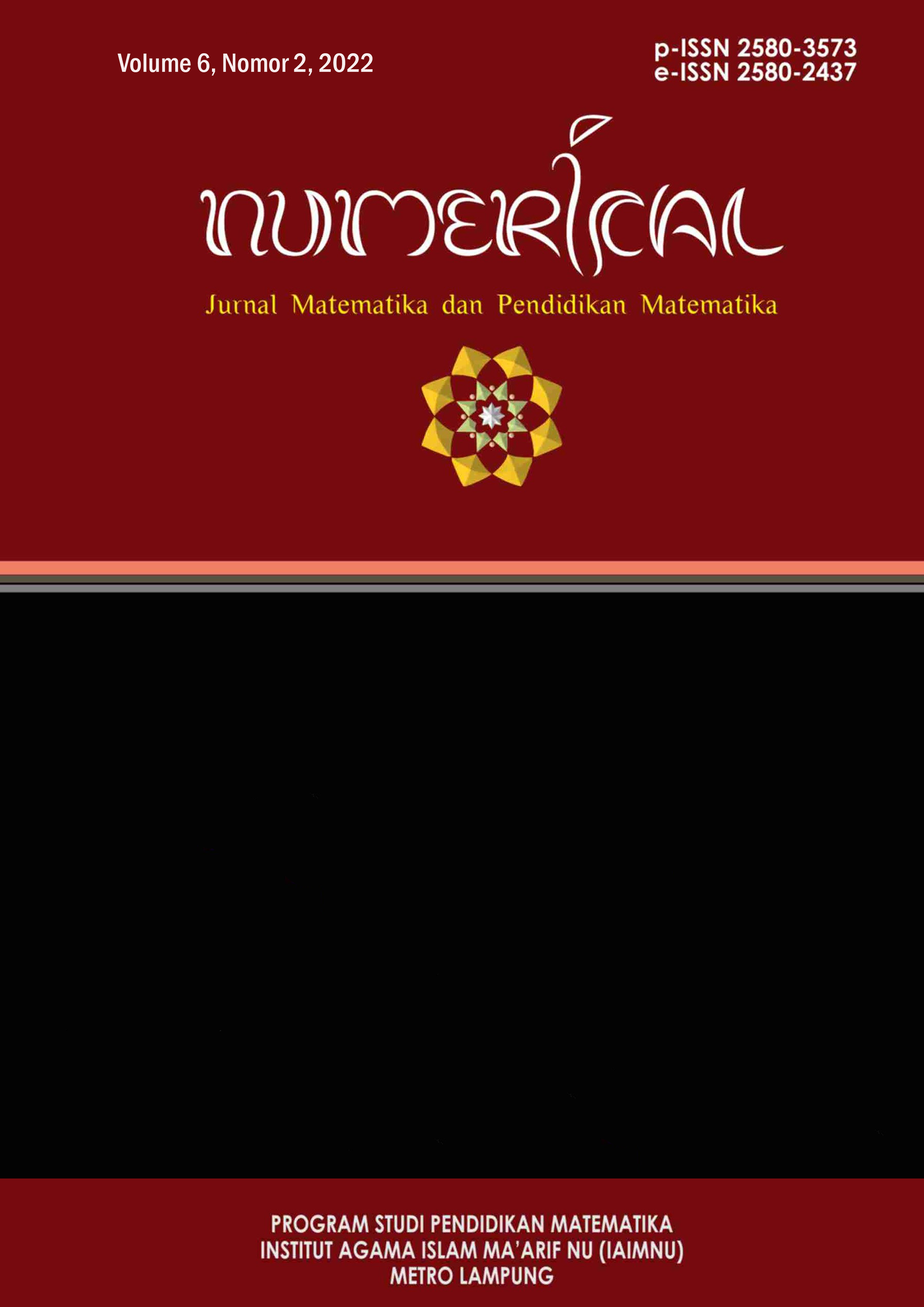Problem Based Learning (PBL) Using Lego in Presenting Data
DOI:
https://doi.org/10.25217/numerical.v6i2.2596Keywords:
Learning Media, Lego, Presenting Data, Problem Based Learning (PBL)Abstract
Problem-solving ability in the learning process is needed to practice Skills in finishing problems, especially in learning mathematics related to life every day. The study aims to know the application of the problem-based learning (PBL) model using Lego in the material presentation of data in Class VII SMPN 2 Pagar Alam. The research method was experimental, with design studies of one-shot cases on all categories. The subjects of this study were class VII students of SMPN 2 Pagar Alam. The sample amounted to 32 students. The data analysis used pre and post-test sheets. From the result analysis, the average value of student learning is 90.58. Thereby implementing the PBL model on the material presentation of data for the results study, students rated very well. Besides that, matter interesting when research students are excited about using Lego as a learning media in the classroom.
References
H. Satriawan, “Problematika Pembelajaran Matematika Pada Materi Statistika SMP Kelas IX,” Jurnal Elektronik Pembelajaran Matematika, vol. 5, no. 3, pp. 278–285, 2018.
A. RA, Matematika. Jakarta: PT. Tiga Serangkai Pustaka Mandiri., 2017.
N. I. Hidayati, “Upaya Meningkatkan Motivasi, Minat, Dan Hasil Belajar Siswa Melalui Model Pembelajaran Team Games Tournament (TGT) Pada Materi Statistika Siswa Kelas VIII E SMP N 3 Salatiga, Kecamatan Sidomukti, Kota Salatiga, Tahun Ajaran 2018/2019,” IAIN Salatiga, 2018.
T. Eliyana, “Keefektifan Model Problem Based Learning Terhadap Hasil Belajar Keliling dan Luas,” vol. 3, no. 1, pp. 40–45, 2014.
F. W. Hasibuan, “Problematika Teacher-Centre Learning : Studi Terhadap Institusi Pendidikan,” Jurnal Pendidikan Terbuka dan Jarak Jauh, vol. 3, no. 4, pp. 1–9, 2016.
P. S. Minhas, A. Ghosh, and L. Swanzy, “The effects of passive and active learning on student preference and performance in an undergraduate basic science course,” Anatomical Sciences Education, vol. 5, no. 4, pp. 200–207, 2012, doi: 10.1002/ase.1274.
T. I. Tawalbeh and A. A. Al Asmari, “Instructors’ Perceptions and Barriers of Learner-Centered Instruction in English at the University Level,” Higher Education Studies, vol. 5, no. 2, pp. 38–51, 2015, doi: 10.5539/hes.v5n2p38.
S. Annisah, “Alat Peraga Pembelajaran Matematika,” Tarbawiyah: Jurnal Ilmiah Pendidikan, vol. 11, no. 1, pp. 1–15, 2017.
H. Suyitno, E. N. Utami, and R. B. Veronica, “The development of geometry concepts understanding based on NCTM reference in learning using discovery learning model,” Unnes Journal of Mathematics Education, vol. 8, no. 1, Art. no. 1, Mar. 2019, doi: 10.15294/ujme.v8i1.28683.
S. Handayani, R. I. I. Putri, and Somakim, “Pemanfaatan Lego pada Pembelajaran Pola Bilangan,” Jurnal Didaktik Matematika, vol. 2, no. 1, pp. 21–32, 2015.
B. Altakhayneh, “The Impact of Using the LEGO Education Program on Mathematics Achievement of Different Levels of Elementary Students,” European Journal of Educational Research, vol. 9, no. 2, pp. 603–610, Apr. 2020.
Z. A. Malinda, M. Murtono, and E. Zuliana, “Problem Based Learning Berbantuan Lego Meningkatkan Pemecahan Masalah Siswa Sekolah Dasar,” Refleksi Edukatika : Jurnal Ilmiah Kependidikan, vol. 8, no. 1, 2017, doi: 10.24176/re.v8i1.1790.
R. Abdurrozak, A. K. Jayadinata, and I. ’atun, “Pengaruh Model Problem Based Learning terhadap Kemampuan Berpikir Kreatif Siswa,” Jurnal Pena Ilmiah, vol. 1, no. 1, pp. 871–880, 2016.
A. Heikkilä and V. Maijala, “Heart failure patients’ experiences of mobile phone-based telemonitoring in self-care: a qualitative systematic review protocol,” JBI database of systematic reviews and implementation reports, vol. 14, no. 5, pp. 68–74, 2016, doi: 10.11124/JBISRIR-2016-001623.
E. Rinaldi and E. A. Afriansyah, “Perbandingan Kemampuan Pemecahan Masalah Matematis Siswa antara Problem Centered Learning dan Problem Based Learning,” NUMERICAL: Jurnal Matematika dan Pendidikan Matematika, vol. 3, no. 1, pp. 9–18, 2019, doi: 10.25217/numerical.v3i1.326.
F. Lontoh and M. Sihombing, “Pembelajaran Terhadap Minat Belajar Mahasiswa,” 2021.
S. I. Lestari, B. Budiyono, and I. Slamet, “Eksperimentasi Model Pembelajaran Problem Based Learning (Pbl), Discovery Learning (DL), dan Problem Possing (PP) Ditinjau dari Kecerdasan Majemuk Siswa,” Jurnal Pembelajaran Matematika, vol. 3, no. 6, pp. 587–598, 2015.
Utama PH; Widyaningrum I; Rahayu C, “Problem based learning terhadap hasil belajar siswa pada materi balok kelas VIII,” Jurnal Penelitian Pendidikan dan Pengajaran Matematika, vol. 4, no. 2, pp. 69–72, 2018.
R. Arends, Learning to Teach. Jakarta: Pustaka Belajar., 2007.
T. Djonomiarjo, “Pengaruh Model Problem Based Learning Terhadap Hasil Belajar,” Aksara: Jurnal Ilmu Pendidikan Nonformal, vol. 5, no. 1, p. 39, 2020, doi: 10.37905/aksara.5.1.39-46.2019.
H. Wardanni, N. Nurdalilah, H. A. Nasution, H. Hidayat, and R. Ramadhani, “Media Pembelajaran Permainan Lego Dalam Meningkatkan Pemahaman Matematika Siswa Pada Materi Pecahan Di SMP Swasta Pembangunan,” Jurnal Altifani Penelitian dan Pengabdian kepada Masyarakat, vol. 2, no. 1, pp. 57–64, 2022, doi: 10.25008/altifani.v2i1.192.
M. A. Lubis, A. Lubis, and Mulyono, “Analysis of Students’ Concepts Understanding Ability in Mathematical Through the Application of Geogebra-Assisted Guided Discovey Learning Model,” JEP, Nov. 2021, doi: 10.7176/JEP/12-32-04.
Downloads
Published
How to Cite
Issue
Section
License
Copyright (c) 2022 Lado Bestra, Chika Rahayu, Helni Indrayati

This work is licensed under a Creative Commons Attribution-ShareAlike 4.0 International License.







